ALMUTASIM MALIK ADAM ELHAJ1 ELTAHIR MOHAMED HUSSEIN2
Department of Computer Science, Faculty of Computer Science and Information Technology, Omdurman Islamic University. E-Mail: almutasim.cs85@gmail.com
2. Associated Professor. College of Engineering Sudan University of Science and Technology (SUST).
HNSJ, 2022, 3(12); https://doi.org/10.53796/hnsj31214
Published at 01/12/2022 Accepted at 10/11/2022
Abstract
Cloud computing is online-based and provides you with resources and information. So, cloud computing supports e-learning and virtual learning. Virtual learning needs high-resolution content. The paper will present the idea of creating a new service. It is a high-quality Virtual Reality (VR)video service across the black box in the cloud environment. This idea helps deal with a large number of scholars in dealing with high-quality Virtual Reality (VR) videos at the same time. The results of the paper are to create a new service in a computer cloud environment (Virtual Reality (VR) – as-a-Service (VRaaS)), using the black box algorithm through which high-quality Virtual Reality (VR) videos pass through. Data obtained in high-quality Virtual Reality (VR) videos and tools used UML, HTML, JavaScript, and PHP.
Key Words: VRaaS, VLES, IaaS, PaaS,SaaS.
1.Introduction
Cloud computing is the use of hosting software on the web service. A network of large computers that make up the cloud deals with the storage function and software that will create a heavy workload for a smaller computer. The aim of cloud computing is to allow users to take advantage of all these technologies, without the need for deep knowledge or experience with each. The cloud aims to reduce costs, helping users focus on their core business rather than being hampered by IT obstacles. Cloud computing also takes care of e-learning in virtual education, which is high quality VR videos, and helps users to recognize the virtual environment via video especially in engineering and medicine.[1] In this paper, we’re going to talk about three sections. Section one Introduction, contain Problem Statement, Aims and Objectives, Contribution, Methodology, Section two contain background, and related works Section three System Overview which contain (System Analysis, Application services component, Computational of black box, black box algorithm, System Implementation). Section four Conclusion.
1.1 Problem Statement
How to leverage the black-box approach for performance estimation using distributed editing of the high-quality VR videos.
Delay increasing when work high-quality VR videos under cloud computing environment in Real-time, without black-box.
1.2 Aims and Objectives
This paper aims to create a new service in the computer cloud to service high-quality VR videos. Also play high quality VR videos via black box to increase its speed and improve its performance in good image. Especially when a large number of users are handled, we need technology to handle high-quality VR videos, especially in the field of virtual learning we need clear content (especially in the medical and engineering fields).
1.3 Contribution
create new services high quality VR videos under cloud computing environment in Real-time.
1.4 Methodology
The Methodology of this research Design new framework to black-box algorithm for high quality VR videos under cloud computing environment in Real-time., using data collection; use scientific paper, books, and internet resources, and data Analysis use UML.
2.Background and Related Works
2.1 Background
Cloud computing refers to configuring, manipulating and accessing apps online. Provides online data storage, application and infrastructure. There are some behind-the-scenes services and models that make cloud computing feasible and accessible to end users. Here are the business models for cloud computing:
- Deployment Models
Deployment models determine the type of access to the cloud, The cloud can have any of the four types of access: public, private, hybrid and community.
- Service Models
Service models are the reference models on which cloud computing is based. These models can be classified into three basic service models as shown below:
1. Infrastructure as a Service (IaaS)
2. Platform as a Service (PaaS)
3. Software as a Service (SaaS)
There are many other service models that can take shape like XaaS, anything as a service. This network can be as a service, acting as a service, identity as a service, database as a service or strategy as a service.[2]
The black box test evaluates the system from outside only, without the operator or tester knowing what is happening within the system to generate responses to the test procedure. The black box refers to a system whose behavior must be fully observed through inputs and outputs. Even if the internal structure of the order under examination can be understood, the tester chooses to ignore it.[3]

Figure (1): Illustrate the Black Box Approach
The potential of immersive environments to promote learning has been known for many years. VR characteristics such as immersion and additional stimulation are often emphasized, as this allows learning in environments where access is often difficult or even impossible. This includes, for example, scenarios such as a school trip to distant historical sites, to another century or to the moon. Besides, realistic settings can be offered in virtual reality to conduct, for example, chemistry experiments, medical processes or physics experiments safely and cost-effectively and can be replicated whenever desired or necessary. With recent advances in technologies and the release of cost-effective consumer-mounted displays (HMDs) such as Oculus Rift and HTC Vive, as well as the possibility of using smartphones as a device for virtual reality experiences, virtual reality again received more attention.[4]
Virtual reality (VR) is a powerful technology that promises to change our lives unlike any other. By artificially stimulating our senses, our bodies become tricked into accepting another version of reality. VR is like a waking dream that could take place in a magical cartoon-like world, or could transport us to another part of the Earth or universe.[5]
The benefits of 3D virtual learning environments (VLES):
- Spatial knowledge representation. Contents that require spatial understanding can benefit from three dimensional visualizations in VLEs.
- Experiential learning. Learning through experimenting in and experiencing of 3D-VLEs provides a better understanding of the subject matter.
- Engagement. Learning tasks in 3D VLEs can foster intrinsic motivation for and engagement with the learning content.
- Contextual learning. Following a constructivist view, learning is always situated within a broader context. Three-dimensional learning environments can resemble real-life situations in which the learning contents can be applied.
- Collaborative learning. 3D VLEs can provide environments where learning can happen through collaboration and social interaction.[4]
2.2 Related Works
Some of the previous scientific papers explain, in their handling of the black box in the computer cloud environment.
study Patrick J. Schroeder and others [6], they conclude that we introduced an approach that can significantly reduce the number of black-box tests. they proposed automated input-output analysis to identify relationships between program inputs and outputs, they conducted an experiment using input-output analysis on a nontrivial C program. they say the results are the program has five user inputs and eight outputs in the form of a transaction record.
study Patrick J. Schroeder and others [7], they conclude that the problem is OneMax cannot be solved in a shorter time than (n log n) with unary variation operators [LW10]. However, the runtime can be reduced to O(n) with binary operators. they proposed to continue the study of the unbiased black-box model introduced in [LW10]. For the first time, we analyze variation operators with arity higher than one. they say the results are results show that already two-ray operators can allow significantly faster algorithms.
study Matthijs Kaminski and others [8], they conclude that the problem is finding a cost-effective assignment of resource allocation policies so that an SLA can be met, has been referred to as the SLA-decomposition problem. they proposed the k8-resource-optimizer framework that is specifically designed for SLA-decomposition in multi-tenant container-based cloud environments. K8-resource-optimizer works with multiple black-box optimization algorithms and has been implemented and evaluated in Kubernetes. They say the results are black-box optimization algorithm that does not require a model of the application.
study John Emmons and others [9], they concluded that developments in deep neural networks (DNNs) and the wide dissemination of video cameras fuelled the need for video analysis systems. Despite the rapid progress in system design, current systems treat DNNs largely as “black boxes” and either fully post models on camera or compress videos for analysis in the cloud. They proposed a new approach to inferring DNN in smart systems, the structure of “brain division,” in which the DNN calculation is divided between the camera in the field and the cloud data centre.
study Darja Krushevskaja and others [10], they concluded that the problem was to understand and explain the brief time of arrival in terms of a few observed features. Understanding the profile of cloud services is a fundamentally important problem. They proposed a synthesis amount that we call a multidimensional f scale and provided algorithms to use to determine the appropriate subset of features that explain the time of arrival. They say the results conduct a detailed empirical study using synthetic data, as well as real data from a large search engine.
3. System Overview
In this section, we will talk about the paper idea, in creating a new service is high quality VR video in the cloud computer environment. Especially in the field of e-learning, we need a hypothetical content to increase e-learning. We need a black box to improve high quality VR videos, especially having a large number of students in dealing with high quality VR videos at the same time. This section includes, system analysis, new system structure, application services component, black box account has high quality professional video, black box algorithm for high quality professional videos, activity chart for black box algorithm, system execution
3.1 System Analysis
In this section, the system is analysed using Unified modelling language (UML). (Figure (2)). In the figure below, the client creates a new account, then enters the system, then deals with high-quality VR videos.
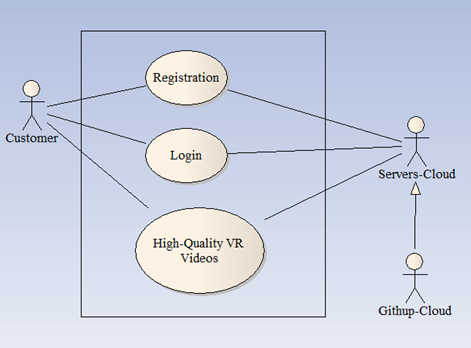
Figure (2): Illustrate the use Case Diagram the basic level for new services for high-quality VR videos on cloud environment
3.2 Architecture of The New System
Displays the components of the new system structure, which works on the concept of processing high-quality VR videos through the Black Box algorithm. The goal is to help the user clearly display high quality VR videos. in figure (3).

Figure (3): illustrate the architecture of the new system
in high quality VR videos
3.3 Application services component
Components are displayed, to create a new VR video service in cloud computing and connect to HTML, database and mobile phone. (In figure (4)), as follows:
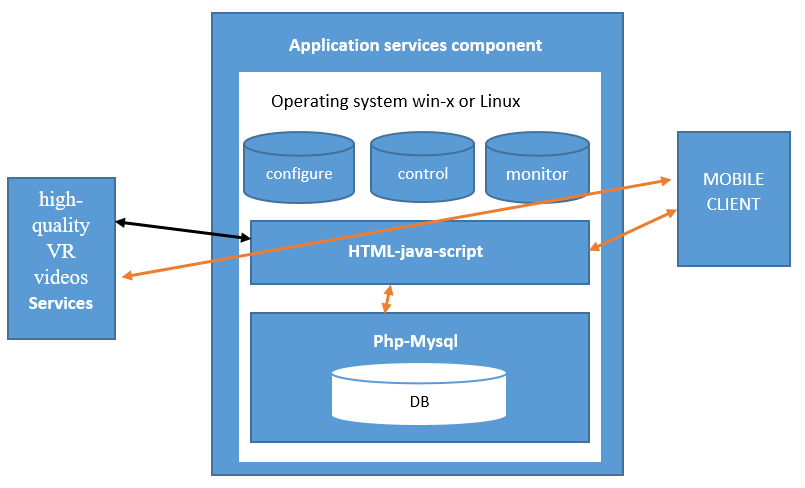
Figure (4): illustrate the high-quality VR videos handling of HTML and database linked to mobile
3.4 Computational of black box over high-quality VR videos
Blackbox P1 has different input and output variables “is an input variable set, and Y is an output variable set. To test high quality VR videos. For Group X can be defined as:
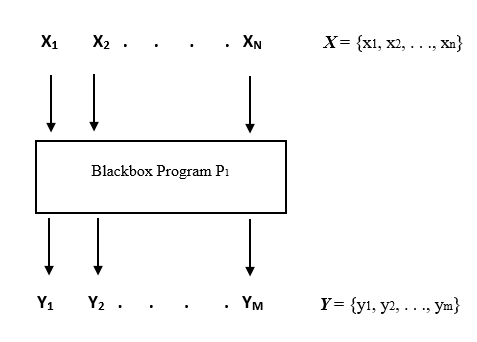
Figure (5): Illustrate the Program P1 with multiple inputs and outputs in black box.
Preconditions describing correct and incorrect data values for each x input variable, (in figure 5). These preconditions can be identified from several sources, including software specifications and computing environment limitations. To create a test kit, it is common to apply black box test (high-quality VR videos), and selection criteria for each input variant for X regarding preconditions. After applying test selection criteria to each variant of X, we will have a set of test values (high quality VR videos) for each of the input variables: D(x1), D(x2), …, D(xn).
Through the Blackbox P1 program (in figure 5) it has different input variables, how to test the program input kits. The most comprehensive method is to test every possible set of selected test data values. In such a case, the T set of aggregate tests is the dicarty product of test data values for individual input variables:
T = D(x1) × D(x2) × …× D(xn).
NT, the number of combinatorial tests, is a very large number (NT = |D(x1) |⋅|D(x2) |⋅ … ⋅|D(xn)|).
Explaining from the above idea, more than one entrance (high quality VR videos) can be handled at the same time by black box, the idea was taken and amended from scientific paper no [11].
3.5 black box algorithm for high-quality VR videos
The idea of a black box algorithm is explained to high-quality VR videos, where high-quality VR video stages are translated, start from entering high-quality VR videos through the black box and VR video processing phases, to appear in high-quality VR video format mp4. The high-quality video algorithm was taken from scientific paper No. [12].
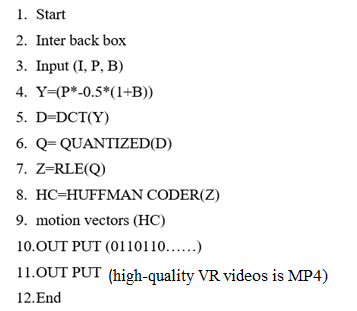
3.6 Activity diagram for black box algorithm for high-quality VR videos
the idea of a black box algorithm for high-quality VR videos is explained, in which the high-quality VR videos stages are translated to come out in high-quality VR videos mp4 format. (In Figure 6).
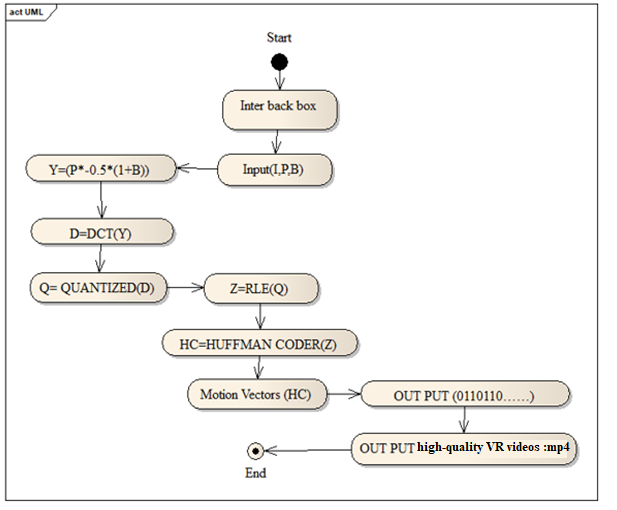
Figure (6): illustrate the Activity diagram for black box algorithm for high-quality VR videos
3.7 System Implementation
A. illustrates the main interface of the cloud environment site, which contains the main page through which the password interface. (In Figure 7).

Figure (7): illustrate the main interface of the cloud environment site
B. illustrates the cloud environment’s password interface, which contains the entry of the username and password through which the cloud service. (In Figure 8).

Figure (8): illustrate the cloud environment’s password interface
C. illustrates the user registration interface of the cloud environment site, through which the client’s data is given access to the cloud service interface. (In Figure 9).
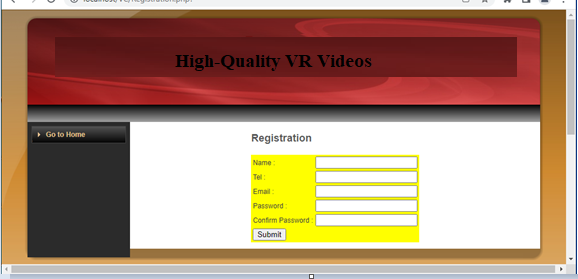
Figure (9): illustrate the user registration interface of the cloud environment site
D: The figure below shows the main interface of the high-quality VR video site in the cloud computing environment
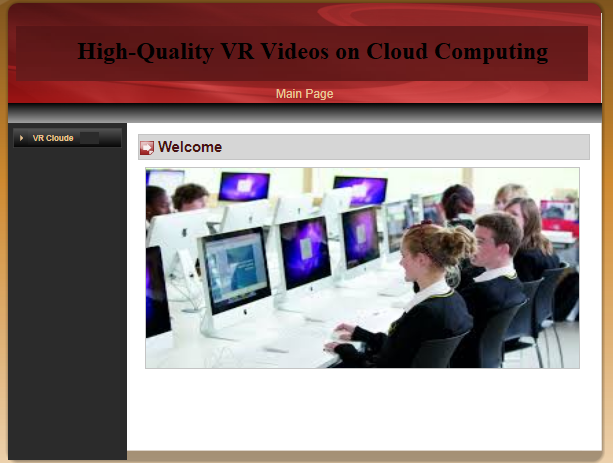
Figure (10): Illustrate the Main Interface of The High-Quality VR Video of Cloud Environment Site
E. illustrates the high-quality VR videos service interface in the black box of the cloud environment site, which contains for high-quality VR videos through which users can view high-quality VR videos in the cloud environment. (In Figure 10).
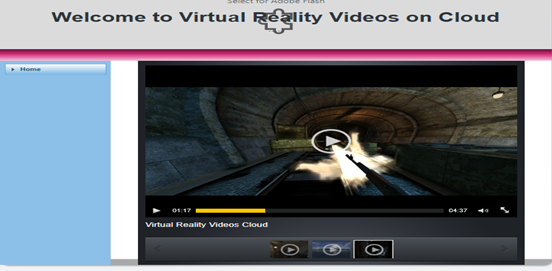
Figure (11): illustrate high-quality VR videos service interface in the black box of the cloud environment site
4.Conclusion
E-learning of the most important type of distance learning through the cloud environment, so it must have clear, readable and fast content for operation or implementation. Especially if the type of content is high quality VR videos, this needs high resolution in content playback, high speed in content playback.
The paper introduces and implements a new service in the cloud environment (high-quality VR videos-as-a-Service (VRaaS)). The black box algorithm, through which high-quality VR videos pass through, has been used.
Also enables to handle a large number of scholars, to play high quality virtual reality videos via the black box at the same time. And also deal with different environments in operating systems, such as (Windows, Linux and Android).
References
[1]M.Aathishvar, N.Madhan Kumar, K.Ganesh,”STUDY ON CLOUD COMPUTING”, International Journal of Contemporary Research in Computer Science and Technology (IJCRCST) e-ISSN: 2395-5325 Volume 4, Issue 1 (January ’2018).
[2]Vivek Paul1, Supriya Pandita2, Prof. Meera Randiva3,” CLOUD COMPUTING REVIEW”, International Research Journal of Engineering and Technology (IRJET) e-ISSN: 2395-0056,Mar-2018.
[3]https://www.techtarget.com/searchsoftwarequalitydefinition/blackbox#:~:text=Black%20box%20testing%20assesses%20a,entir ly%20by%20inputs%20and%20outputs,2022.
[4] Steven M. LaValle,” Virtual Reality”, University of Oulu, 2019
[5] Johanna Pirker, Andreas Dengel,” The Potential of 360-Degree Virtual Reality Videos and Real VR for Education – A Literature Review”, in IEEEComputer Graphics and Applications, doi: 10.1109/MCG.2021.
[6] Patrick J. Schroeder and Bogdan Korel,’” Black-Box Test Reduction Using Input-Output Analysis”’, ISSTA’00, Portland, Oregon,Copyright ACM 1-58113-266-2/00/0008, 2000.
[7] Benjamin Doerr1,Per Kristian Lehre2,Daniel Johannsen1,Markus Wagner1,Timo Kötzing1y,Carola Winzen1,’ “Faster Black-Box Algorithms Through Higher Arity Operators”’, FOGA’11, January 5–9, , A-6867 Schwarzenberg, Austria, Copyright 2011 ACM 978-1-4503-0633-1/11/01, 2011.
[8] Matthijs Kaminski, Eddy Truyen, Emad Heydari Beni, Bert Lagaisse, Wouter Joosen, “A framework for black-box SLO tuning of multi-tenant,applications in Kubernetes”, Davis, CA, USA, , WOC ’19, December 9–13, 2019.
[9] John Emmons•, Sadjad Fouladi•, Ganesh Ananthanarayanan_,”Cracking open the DNN black-box: Video Analytics,with DNNs across the Camera-Cloud Boundary”, HotEdgeVideo, , Los Cabos, Mexico,2019 Association for Computing Machinery,ACM ISBN 978-1-4503-6928-2/19/10., October 2019.
[10] Darja Krushevskaja, Mark Sandler,” Understanding Latency Variations of Black Box Services”, Copyright is held by the International World Wide Web Conference,Committee (IW3C2). IW3C2 reserves the right to provide a hyperlink,to the author’s site if the Material is used in electronic media., May 13–17, 2013.
[11] Patrick J. Schroeder and Bogdan Korel,” Black-Box Test Reduction Using Input-Output Analysis”, ACM 1-58113-266-2/00/0008,2000.
[12] T.Sikora,” MPEG-1 and MPEG-2 Digital Video Coding Standards”, Digital Consumer Electronics Handbook -McGRAW-HILL BOOK COMPANY,2018.
